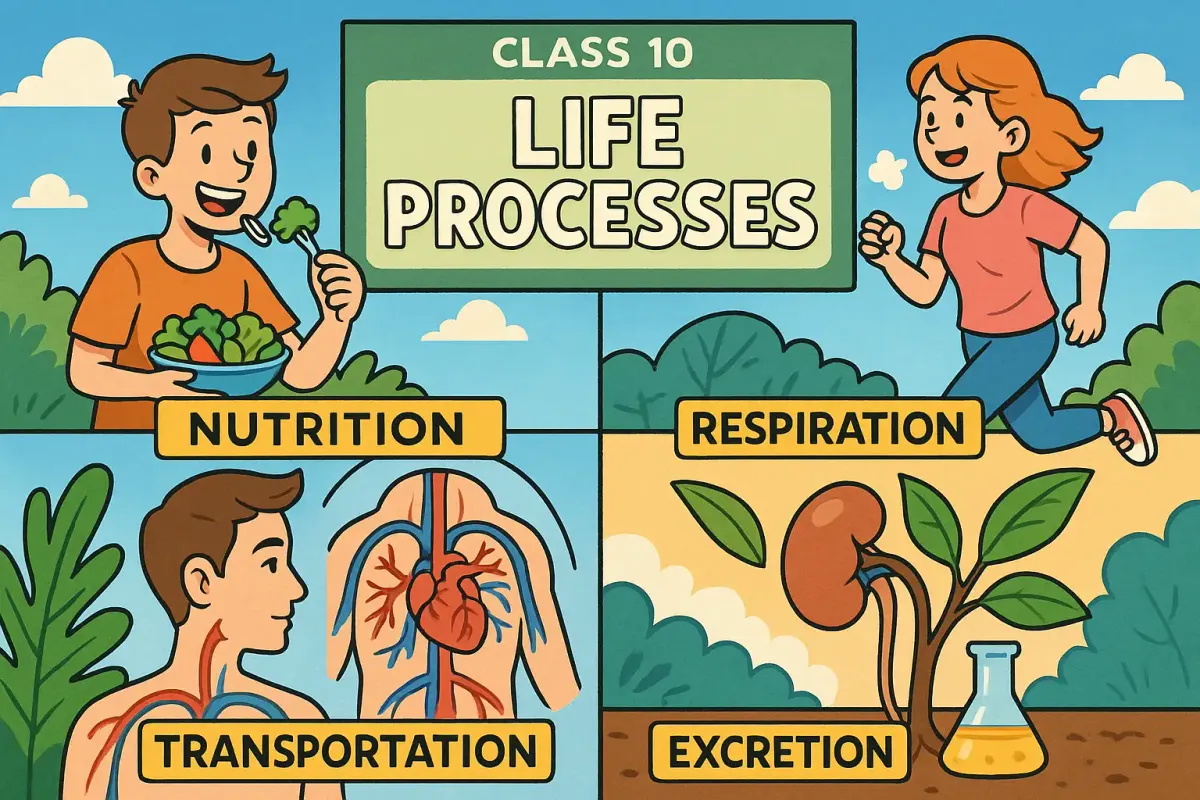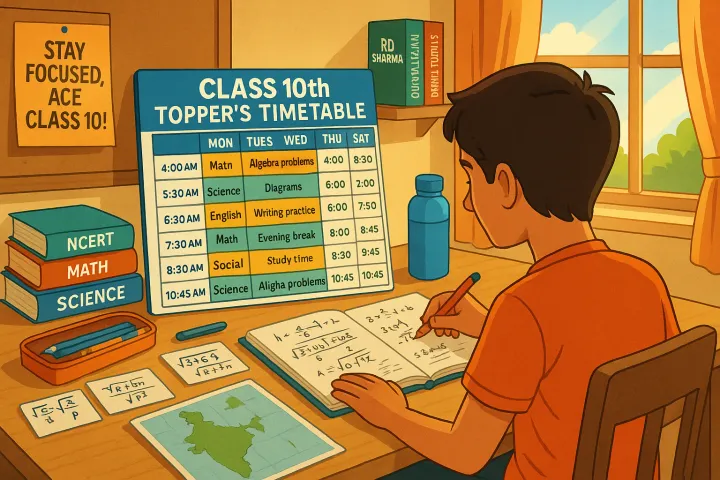Class 10th science biology chapter life process PDF download and notes download
Definition of Life Processes: Life processes are the essential activities performed by living organisms to maintain life. These include nutrition.

Life Processes - Class 10 Science Notes
Definition of Life Processes: Life processes are the essential activities performed by living organisms to maintain life. These include nutrition, respiration, transportation, and excretion.
1. Nutrition
Nutrition is the process by which organisms obtain and utilize food to meet energy and growth requirements.
Types of Nutrition
- Autotrophic Nutrition: Organisms (e.g., green plants) prepare their own food using sunlight, water, and carbon dioxide through photosynthesis.
- Photosynthesis:
- Equation: 6CO₂ + 6H₂O → C₆H₁₂O₆ (glucose) + 6O₂
- Occurs in chloroplasts, which contain chlorophyll (green pigment).
- Raw materials: Carbon dioxide (from air via stomata) and water (from soil via roots).
- Conditions required: Sunlight, chlorophyll, CO₂, and water.
- By-products: Oxygen is released.
- Diagram: Cross-section of a leaf showing stomata, guard cells, and chloroplasts.
- Photosynthesis:
- Heterotrophic Nutrition: Organisms depend on other organisms for food.
- Types:
- Holozoic: Ingesting and digesting food (e.g., humans, animals).
- Saprophytic: Feeding on dead organic matter (e.g., fungi).
- Parasitic: Deriving nutrients from a living host (e.g., tapeworm, lice).
- Types:
Nutrition in Amoeba
- Process: Holozoic nutrition via phagocytosis.
- Amoeba engulfs food using pseudopodia, forms a food vacuole, digests it, and expels waste via diffusion.
- Diagram: Amoeba showing pseudopodia and food vacuole.
Nutrition in Humans
- Human Digestive System:
- Organs: Mouth, esophagus, stomach, small intestine, large intestine, rectum, and anus.
- Accessory Organs: Salivary glands, liver, pancreas, gallbladder.
- Process:
- Ingestion: Food intake via the mouth.
- Digestion: Breakdown of complex food into simpler molecules.
- Mouth: Saliva (contains amylase) breaks down starch into maltose.
- Stomach: Gastric juices (HCl, pepsin) digest proteins into peptides.
- Small Intestine: Bile (from liver) emulsifies fats; pancreatic juices digest carbohydrates, proteins, and fats. Villi absorb nutrients.
- Large Intestine: Absorbs water; forms and stores feces.
- Absorption: Nutrients are absorbed in the small intestine via villi.
- Assimilation: Nutrients used by cells for energy and growth.
- Egestion: Removal of undigested waste via the anus.
- Diagram: Human digestive system with labeled parts (mouth, stomach, intestines, etc.).
2. Respiration
Respiration is the process of breaking down food (glucose) to release energy for cellular activities.
Types of Respiration
- Aerobic Respiration:
- Occurs in the presence of oxygen.
- Takes place in mitochondria.
- Equation: C₆H₁₂O₆ + 6O₂ → 6CO₂ + 6H₂O + 38 ATP (energy).
- Common in most organisms (e.g., humans, animals).
- Anaerobic Respiration:
- Occurs in the absence of oxygen.
- Produces less energy.
- Examples:
- In yeast: Glucose → Ethanol + CO₂ + 2 ATP (fermentation).
- In muscle cells (during heavy exercise): Glucose → Lactic acid + 2 ATP.
- Equation (Yeast): C₆H₁₂O₆ → 2C₂H₅OH + 2CO₂.
Respiration in Humans
- Respiratory System:
- Organs: Nostrils, nasal cavity, pharynx, larynx, trachea, bronchi, bronchioles, alveoli, lungs.
- Process:
- Inhalation: Diaphragm and intercostal muscles contract, increasing chest volume, drawing air into lungs.
- Exhalation: Diaphragm and muscles relax, reducing chest volume, expelling air.
- Gas Exchange: In alveoli, oxygen diffuses into blood, and CO₂ is removed from blood to be exhaled.
- Diagram: Human respiratory system showing alveoli, trachea, and lungs.
- Transport of Gases:
- Oxygen binds to hemoglobin in red blood cells and is transported to tissues.
- CO₂ is transported back to the lungs (mostly as bicarbonate ions).
3. Transportation
Transportation is the process of moving nutrients, gases, and waste products within an organism.
Transportation in Humans
- Circulatory System:
- Components: Heart, blood, blood vessels (arteries, veins, capillaries).
- Blood Components:
- Plasma: Carries nutrients, hormones, and waste.
- RBCs: Carry oxygen via hemoglobin.
- WBCs: Fight infections.
- Platelets: Help in blood clotting.
- Heart:
- Four chambers: Two atria (receive blood) and two ventricles (pump blood).
- Double circulation: Pulmonary (heart to lungs) and systemic (heart to body).
- Diagram: Human heart showing chambers, valves, and blood flow (oxygenated vs. deoxygenated blood).
- Blood Vessels:
- Arteries: Carry oxygenated blood away from the heart (except the pulmonary artery).
- Veins: Carry deoxygenated blood to the heart (except the pulmonary vein).
- Capillaries: Site of nutrient and gas exchange.
Transportation in Plants
- Xylem: Transports water and minerals from roots to leaves.
- Driven by transpiration pull (evaporation of water from leaves creates suction).
- Phloem: Transports food (glucose) from leaves to other parts via translocation.
- Diagram: Cross-section of a plant stem showing xylem and phloem.
4. Excretion
Excretion is the removal of metabolic waste products from the body to maintain homeostasis.
Excretion in Humans
- Excretory System:
- Organs: Kidneys, ureters, urinary bladder, urethra.
- Kidneys:
- Functional unit: Nephron.
- Process: Filtration (glomerulus filters blood), reabsorption (water, glucose reabsorbed), secretion (waste like urea added), and urine formation.
- Urine: Contains water, urea, and other wastes; stored in the bladder and expelled via the urethra.
- Other Excretory Organs:
- Lungs: Excrete CO₂.
- Skin: Excretes sweat (water, salts, urea).
- Liver: Converts ammonia to urea.
- Diagram: Human excretory system and nephron structure.
Excretion in Plants
- Plants excrete waste via:
- Stomata: Release oxygen and water vapor.
- Lenticels: Release CO₂ in woody stems.
- Shedding: Leaves or bark remove stored wastes.
- Resins/Gums: Excrete waste products in some plants.
Key Diagrams to Study
- Photosynthesis: Cross-section of a leaf showing stomata and chloroplasts.
- Amoeba: Phagocytosis process.
- Human Digestive System: Mouth to anus with accessory organs.
- Human Respiratory System: Alveoli and lungs.
- Human Heart: Double circulation and blood flow.
- Plant Transport: Xylem and phloem in the stem.
- Human Excretory System: Kidneys and nephron.
Important Points for Exams
- Definitions: Define life processes, autotrophic/heterotrophic nutrition, aerobic/anaerobic respiration, etc.
- Equations: Memorize photosynthesis and respiration equations.
- Diagrams: Practice labeling diagrams accurately.
- Functions: Understand the role of each organ/system in life processes.
- Differences: Be able to compare aerobic vs. anaerobic respiration, xylem vs. phloem, etc.
- Examples: Relate processes to real-life examples (e.g., fermentation in yeast, lactic acid in muscles).
Download the PDF of notes on life processes
Download the PDF NCERT class 10th Life Process chapter.
Thanks, and join our WhatsApp community for the latest updates.

Share and subscribe to the blog by email.





Comments ()